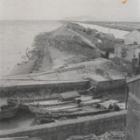Elvin, Mark, and Su Ninghu. “Man Against the Sea: Natural and Anthropogenic Factors in the Changing Morphology of Harngzhou Bay, circa 1000–1800.” Environment and History 1, no. 1 (Feb., 1995): 3–54. doi:10.3197/096734095779522690 Inner Harngzhou Bay, on the east coast of China at approximately 30 degrees N, is an unstable macro-tidal estuarine system whose geographical configuration has altered dramatically over the last thousand years. A thousand years ago there was an approximate balance between the deposition of sediments, mostly brought in by the tides from the mouth of the Yarngzii immediately to the north, and their removal by river flow, especially at periods of peak discharge, in conjunction with ebb tides. Human intervention made a major contribution to disrupting this equilibrium by the building of sea-walls, the diversion of rivers, and the reduction of peak discharge, in part by storing water in irrigation systems. The shift of the Yellow River to a predominantly southern course after 1194, and especially the increased discharge of fine-grain sediment at its sea-mouth as the result of hydraulic engineering in 1578-9, also played a part, by increasing the quantity of fine-grain sediments transported southwards down the coast. The present paper summarizes and interprets previous work on the hydrology and hydraulics of this area, presents a preliminary reconstruction of the geographical pattern of change based on historical maps and documents, and outlines some of the analytical problems that will need to be addressed in the future. It also shows that—under certain circumstances—geomorphologic change, partly anthropogenic in origin, can affect human social and economic life over relatively short periods (typically tens to hundreds of years). The conclusion is that long-term economic history without environmental history is, at best, lopsided and, at worst, misleading. All rights reserved. © 1995 The White Horse Press
"Man Against the Sea: Natural and Anthropogenic Factors in the Changing Morphology of Harngzhou Bay, circa 1000–1800"
Elvin, Mark, and Su Ninghu | from Multimedia Library Collection:
Environment and History (journal)


